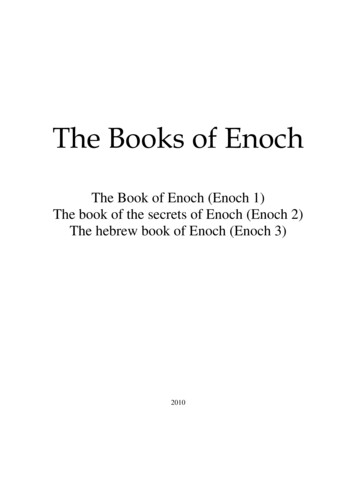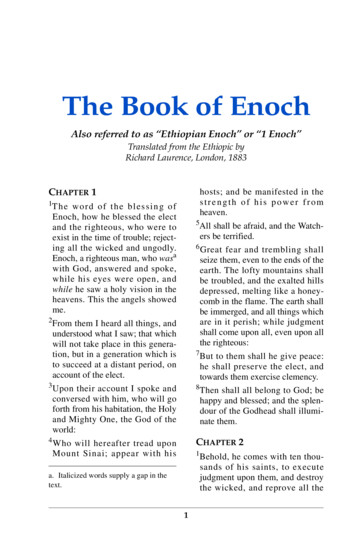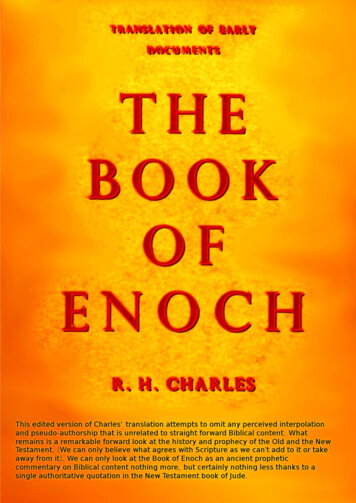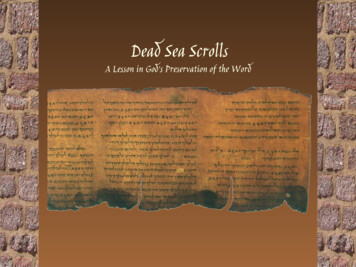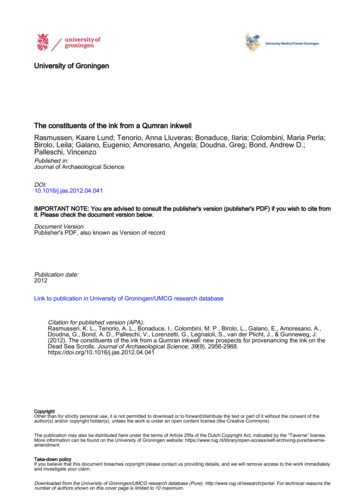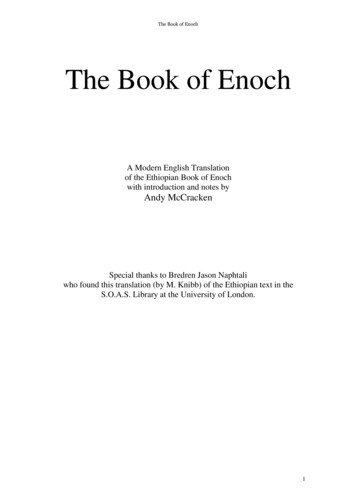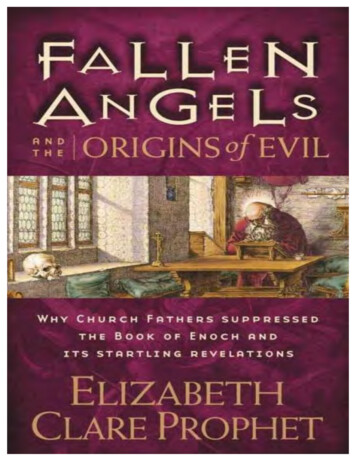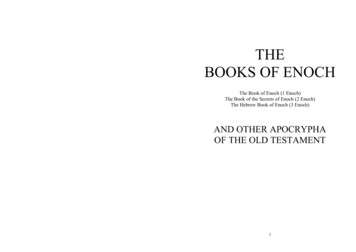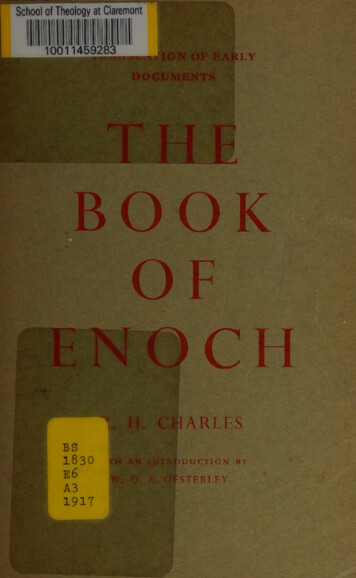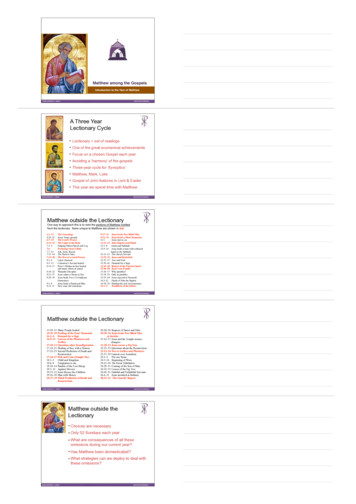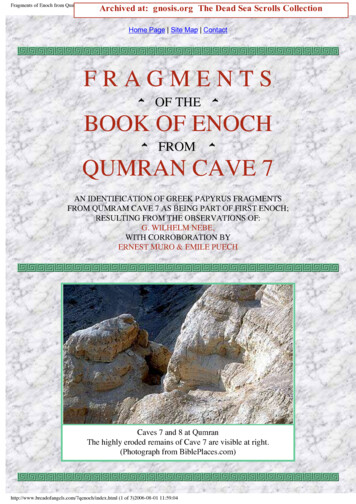
Transcription
Fragments of Enoch from Qumran cave 7Archived at: gnosis.org The Dead Sea Scrolls CollectionHome Page Site Map ContactFRAGMENTSOF THEBOOK OF ENOCHFROMQUMRAN CAVE 7AN IDENTIFICATION OF GREEK PAPYRUS FRAGMENTSFROM QUMRAM CAVE 7 AS BEING PART OF FIRST ENOCH;RESULTING FROM THE OBSERVATIONS OF:G. WILHELM NEBE,WITH CORROBORATION BYERNEST MURO & EMILE PUECHCaves 7 and 8 at QumranThe highly eroded remains of Cave 7 are visible at right.(Photograph from ch/index.html (1 of 3)2006-08-01 11:59:04
Fragments of Enoch from Qumran cave 7Before entering this site read the Prologue.Then read a Synopsis of the identification process. This page includes photos.Read my Article in Revue de Qumran #70 on this subject.Read Companion Article by Fr. Emile Puech in Revue de Qumran #70.Read an English translation and analysis of the pertinent Greek text.Read my Refutation of Carsten Peter Thiede's rejection of the 7QEnoch identification.Click here to read my observations and opinions regarding Fragment 7Q5.Click here to access Outside Links.Click here to return to the Main Entrance to all my other web sites.As Loved.So Love(John 13:34)Return to Main .html (2 of 3)2006-08-01 11:59:04
Fragments of Enoch from Qumran cave 7mailto:emuro@breadofangels.comAugust 19, 1999 / March 22, l (3 of 3)2006-08-01 11:59:04
Main EntranceMAIN ENTRANCEBread Of Angels Web SiteDIRECTORYSITE MAPGo to: Site Map for a complete list of topics and pages at this web site.KNIGHTS OF COLUMBUSGo to: Knights of Columbus Council 12402. St. James Cathedral, Orlando, Fl.DEAD SEA SCROLLSGo to: Fragments of Enoch from Qumran Cave 7.Go to: A Defense of the 7QEnoch Identification, contra Carsten Thiede, et al.Go to: 7Q5: "Disloqué à Droite", Key to the Controversy.Go to: 7Q6: Can the Computer Be of Any Help?Go to: 7Q20: What is it? Where is it?Go to: 7Q21: What is it? Where is it?PERSONALGo to: My Testimony. Jesus got you?Go to: The Lake Cherokee Historic District: Antique postcard collection.http://www.breadofangels.com/index.html (1 of 3)2006-08-01 11:59:05
Main EntranceGo to: The LoPresti Christmas Village: 1969-1973.Go to: The Molten Sea and the Value of Pi: Can ! be found "in" Scripture?Go to: Quanta Cura vs. Vatican II: Do they contradict each other?ONLINE AUCTION SALESAuction Items:Go to: My Online Auctions at eBay: Click on the eBay logo:Dear Visitors:When I first launched this web site on August 19, 1997, I had no idea that it would eventually bementioned in books and other publications about the Dead Sea Scrolls. Furthermore, this site has grownincrementally over the years with no overall means of navigating or organizing the pages within.Consequently, I am presently in the process of compiling a site map that will list and provide links to all theindividual web pages at this site.Keep in mind that http://www.netcom.com/ emuro/index.html, the original URL or web address for thissite, has been defunct since 1999.I can now be contacted by e-mail at: emuro@breadofangels.com Please be patient with these changes,as I must endeavor to be patient with this matter as well.Ernest A. Muro, Jr.March 31, 2003http://www.breadofangels.com/index.html (2 of 3)2006-08-01 11:59:05
Main EntranceAugust 19, 1997 / March 14, 2006http://www.breadofangels.com/index.html (3 of 3)2006-08-01 11:59:05
Site MapHome Page ContactSITE MAPforhttp://www.breadofangels.comA. DEAD SEA SCROLLS: QUMRAN CAVE 71a. 7QEnoch (7Q4, 7Q8, 7Q12, etc.)Fragments of the Book of Enoch from Qumran Cave 7Prologue - A Steep and Rugged Ascent7QEnoch: A Synopsis of the Identification ProcessThe Greek Fragments of Enoch from Qumran Cave 7 (Article by Ernest Muro in Revue deQumran #70)Seven Greek Fragments of the Epistle of Enoch from Qumran Cave 7 (Article by Emile Puech inRQ #70)The Greek Text of the 7QEnoch Fragments: Analysis and Translation1b. 7QEnoch: ImagesEnlarged Photograph of the 7QEnoch Ensemble from RQ #70, p. 312Locations of this Photograph in PrintEnlarged Photograph of the 7QEnoch Ensemble from the 1996 Rimini Meeting.1c. 7QEnoch: Rebuttals, CommentaryMy Refutation of Carsten Peter Thiede's Rejection of the 7QEnoch Identification by way of ananalysis of the arguments put forth by Thiede in his book: "The Dead Sea Scrolls and the JewishOrigins of Christianity."Looking in Vain for the Eta on Line 1 of 7Q4,1: An Account of how a mere Shadow became aDoubt.2. 7Q5General Information7Q5: "Disloqué à Droite", Key to the ControversyNo Nu in Line 2 of 7Q5, Part 1: Is the Definitive Dark Spot on Carsten Peter Thiede's HighResolution Photograph a Trace of Writing, or is it Poopie?No Nu in Line 2 of 7Q5, Part 2: An Evaluation of the Papyrological Evidence versus the Claimsmade by Carsten Peter Thiede in The Dead Sea Scrolls and the Jewish Origins of Christianity.3. 7Q67Q6: Can the Computer Be of Any Help?http://www.breadofangels.com/sitemap.html (1 of 2)2006-08-01 11:59:06
Site Map4. 7Q207Q20: What is it? Where is it?5. 7Q217Q21: What is it? Where is it?B. KNIGHTS OF COLUMBUS1. K. of C. Council 12402, St. James Cathedral, Orlando, FloridaK. of C. Council 12402 Home PageMarch 31, 2003 / March 14, 2006http://www.breadofangels.com/sitemap.html (2 of 2)2006-08-01 11:59:06
PrologueHome Page Site Map ContactPROLOGUE.A STEEP AND RUGGED ASCENT.The words: ."a steep and rugged ascent". are from Plato's Allegory of the Cave, which is foundin chapter 7 of his book: "The Republic." This famous allegory begins by describing a group ofpeople who are imprisoned in a cave. Their knowledge is limited to viewing shadows that have beenprojected onto the walls of the cave. As the allegory develops, this world of shadowy images iscontrasted with that of real objects as seen in broad daylight. Plato illustrates this contrast bydescribing the experience of a man who learns the truth about the shadows on the cave walls. Thisman then leaves the cave by way of "a steep and rugged ascent" out of illusion and intoenlightenment. Such an ascent represents a turning point in the allegory; as it emphasizes the effortrequired in abandoning illusion and in opening oneself to the fullness of truth.My drawing attention to Plato's Allegory of the Cave has little to do the fact that the Qumranscrolls were found in caves; although parts of the surrounding terrain can readily be described as"steep and rugged." The relevance of Plato's Allegory has to do with the effort required in identifyingthe contents of the Qumran caves and in understanding their significance. In the case of Qumran cave7, the "steep and rugged ascent" has included some wrong turns. Some of the papyrus fragments wereincorrectly identified; and this has led to a variety of dubious and premature conclusions. As scholarsvigorously opposed each other about the identification and significance of these fragments; theirefforts resembled more of a groping about than an ascent from the quandary that has become thelegacy of cave 7. The abundance of books and articles on this subject has been the fruit of awidespread controversy that has even attracted public interest from time to time.One of these books was "The First New Testament" by David Estrada & William White, Jr.; whichwas published in 1978. I first learned of the controversy when I purchased a copy of this book in1982. I did not give the matter serious attention until 1997; when I decided to use my computer toscan the text of the Bible in order to locate places in the Biblical text that corresponded to the letterson the papyrus fragments. I also intended to publish the results of my scans on a web site on theInternet. After analyzing the two fragments that comprise the set known as 7Q6, I published theresults of my observations on my web site; which I launched in August of 1997. Consequently, Ireceived an e-mail from someone who informed me that Emile Puech of the Ecole Biblique hadwritten an article in a journal where he argues that fragment 7Q4 was part of the book of Enoch.Meanwhile, I also had a suspicion that fragments 7Q4 and 7Q8 were from the same scroll becauseboth fragments had horizontal fibers that sloped slightly downward in the same direction. Thissuspicion of mine was the result of my carefully examining the photographs in Estrada & White inorder to determine which Greek letters were actually on the papyrus fragments. After obtaining acopy of the Greek text of Enoch, I was able to locate all the letters on fragment 7Q8 in a position inthe printed text very close to the location of the wording of fragment 7Q4 as described by EmilePuech. On the following day, September 16, I carefully made photocopies of these two fragments tml (1 of 3)2006-08-01 11:59:07
Prologuesuperimposed them in such a manner that the papyrus fibers of both fragments were in perfectalignment. I was then able to do this with fragment 7Q12. All three fragments fit together in anensemble like pieces of a jigsaw puzzle and all the legible letters correctly corresponded to the printedtext of chapter 103 of the book of Enoch.In order to get assistance in publishing the results of my discovery, I sought advice from fivescholars who had been involved in the controversy. One of them, Emile Puech, immediatelyexpressed an interest in the matter and he asked me to write an article for inclusion in the next issueof Revue de Qumran; which is a scholarly journal devoted to Qumran studies. He also wrote acompanion article where he demonstrated that another three fragments should be added to theensemble. These articles were then published in the December 1997 issue of Revue de Qumran andthey became available in June of 1998. These articles, one in English and the other in French, are of atechnical nature that is characteristic of scholarly publications. In order to make them moreunderstandable, I have written this prologue; and I have also supplied a brief glossary.As regards acknowledgements I must give credit to G. Wilhelm Nebe; who was the first topropose that fragments 7Q4 and 7Q8 were part of the book of Enoch. I must also give thanks to EmilePuech and Florentino Garcia Martinez for their assistance and for their inviting me to publish myarticle in Revue de Qumran. This is an honor for which I will always be grateful.Most of all, I must give glory to God for His having granted me this opportunity, and for Hisleading me to take the steep and rugged ascent. It is my firm conviction that in due time the Gospel ofJesus Christ will be further corroborated by new discoveries of manuscripts, along with morearchaeological evidence. Meanwhile, the steep and rugged ascent continues.Ernest A. Muro, Jr.July 8, 1998Continue by reading the Synopsis of the identification.To read my article in Revue de Qumran #70, click here.Read companion article by Fr. Emile Puech in Revue de Qumran #70.For the Glossary, click here.Click here to return to index of "Fragments of Enoch from Qumran Cave 7".Click here to return to the Main Entrance to all my other web e.html (2 of 3)2006-08-01 11:59:07
och/prologue.html (3 of 3)2006-08-01 11:59:07
SynopsisHome Page Site Map Contact7Q ENOCH:A SYNOPSIS OF THE IDENTIFICATION PROCESSThe purpose of this synopsis is to provide an overview of how I was involved in clarifying theidentification of certain Qumran cave 7 fragments. These fragments included the pair known as:7Q4,1&2; along with the individual fragments known as: 7Q8; and 7Q12. Three of these fourfragments are certainly part of I Enoch 103:3-8. The fourth fragment, which is 7Q4,2, consists ofonly three letters and has yet to be located in the text of I Enoch with certainty. These four fragmentsare depicted below.When the cave 7 fragments were first published in 1962, only fragments 7Q1,1&2 and 7Q2 wereidentified. In 1972 Fr. Jose O'Callaghan, S.J. attempted to identify another nine fragments. His effortsresulted in a controversy; as he proposed that all of these nine fragments were from the NewTestament. These controversial identifications included 7Q4,1&2 and 7Q8; as Fr. O'Callaghanthought that 7Q4,1&2 was part of I Timothy 3:16-4:3 and 7Q8 part of James 1:23-24. To the best ofmy knowledge, nobody had ventured to identify 7Q12; as it preserves only three letters, all of themvowels. Because of their size, other scholars attempted to identify fragments 7Q4,1 and 7Q8. None ofthese attempts, however, were ever regarded as conclusive or final. One of these alternatives to Fr.O'Callaghan's identifications was made by G. Wilhelm Nebe; and it is described in an article by tml (1 of 5)2006-08-01 11:59:08
Synopsisthat was published in Revue de Qumran in 1988. In this article Prof. Nebe proposed that fragments7Q4,1&2 and 7Q8 were not part of the New Testament but part of I Enoch. He convincinglydemonstrated that fragment 7Q4,1 was part of I Enoch 103:3-4; while he thought that fragment 7Q4,2was part of I Enoch 98:11. With much reservation, he also suggested that fragment 7Q8 was part of IEnoch 103:7-8. Although his observations were contested by other scholars such as Carsten P.Thiede; they were defended by Fr.Emile Puech in a 1996 article in Revue Biblique.In 1997, out of curiosity, I endeavored to use my computer to shed some light on the controversy.I had just installed "Bible Works for Windows." This software, which is published by Hermeneutika,can do more than simple word searches; as it enables one to search the Greek texts of the Septuagintor the New Testament for any sequence of letters. With these capabilities in mind I began to scan theGreek Biblical text for possible locations or "hits" of groups of letters that are visible on variousfragments from cave 7. I began with the pair of fragments knowm as 7Q6,1&2; and I published theresults on my web site on August 19 of that year. A few days later, a visitor to my site informed meby e-mail about the possibility that 7Q4 was part of I Enoch. He referred to the article written by Fr.Emile Puech in 1996 that appeared in Revue Biblique. After reading this article I learned that theattempt was originally made by G. Wilhelm Nebe in 1988.At about the same time, I suspected that fragments 7Q4,1 and 7Q8 were originally part of thesame scroll. After closely studying photographs of these two fragments, I noticed that the horizontalpapyrus fibers on both fragments had a characteristic downward slope to the right. I then reasonedthat if Prof. Nebe was right about 7Q4,1&2 as being part of I Enoch; then fragment 7Q8 should alsobe part of it as well. After locating a copy of the Greek text of I Enoch, I observed the locations of theGreek letters from fragments 7Q4,1 and 7Q8 in close proximity in chapter 103. In order to confirmthis observation, I made photocopies of these two fragments and superimposed them to see whetherthe papyrus fibers matched. Much to my surprise they did! Furthermore, I was able to add fragment7Q12 to the group. All three fragments fit like pieces of a jigsaw puzzle and the position of all theletters corresponded correctly with Greek text of I Enoch as found in the printed edition. Thishappened on September 16, 1997. The manner in which these three fragments are related to oneanother is shown in the picture s.html (2 of 5)2006-08-01 11:59:08
SynopsisAll previous efforts to identify these fragments had been hampered by the assumption that thesefragments were originally from different scrolls. To the best of my knowledge no one had taken intoconsideration the unique characteristics of the papyrus fibers. The result was an impasse, as eachfragment in itself was too small to identify with certainty. If it could be shown that these threefragments were originally related to each other in the scroll; then the impasse or difficulty would beresolved. The following picture shows these three fragments in their original configuration in thescroll. Some of the papyrus fibers should be visible in this image. Because of the matching papyrusfibers, one should not attempt to identify three separate fragments but one ensemble that consists ofthree fragments. In essence, one is really dealing with one large fragment. This ensemble is /synopsis.html (3 of 5)2006-08-01 11:59:08
SynopsisIn addition to the fact that the papyrus fibers match perfectly; the position of all the Greek letterscorresponds correctly with that of the printed text of I Enoch. After having made this observation, Icontacted five scholars that had been involved in the controversy. One of them, Fr. Emile Puech,invited me to write an article for inclusion in issue number 70 of Revue de Qumran. This issue isdated December 1977 and was printed in May 1998. It became available in June. In this issue Fr.Puech wrote a companion article which builds upon my observations. In this article he demonstratesthat fragment 7Q14 is located about two inches to the left of 7Q12; in the text of I Enoch 103:4. Healso suggests that fragment 7Q11 is part of I Enoch 100:12 and that fragment 7Q13 is part of I Enoch103:15. In keeping with his 1996 article in Revue Biblique, Fr. Puech maintains that fragment 7Q4,2is part of I Enoch 105:1; as opposed to the identification proposed by G. Wilhelm Nebe, which iscorrect in all other psis.html (4 of 5)2006-08-01 11:59:08
SynopsisClick here to read my article in Revue de Qumran #70.Read companion article by Fr. Emile Puech in Revue de Qumran #70.Click here to go to the GlossaryClick here to return to index of "Fragments of Enoch from Qumran Cave 7".Click here to return to the Main Entrance to all my other web h/synopsis.html (5 of 5)2006-08-01 11:59:08
Article1Home Page Site Map ContactARTICLE INREVUE DE QUMRAN #70byERNEST A. MURO, JRTHE GREEK FRAGMENTS OF ENOCH FROM QUMRAN CAVE 7(7Q4, 7Q8, & 7Q12 7QEn gr Enoch 103:3-4, 7-8)Note: if you need to use the Glossary click hereIn 1955 Qumran cave 7 was excavated and twenty-four small scroll fragments were found. All werewritten in Greek and on papyrus; although three had survived only as imprints upon clay lumps. When theeditio princeps (1) was published in 1962, these fragments were arranged into nineteen groups andnumbered accordingly; for it was observed that some fragments were evidently from identical scrolls. (2)At that time only fragments 7Q1,1&2 and 7Q2 were identified. In 1972 O'Callaghan attempted to identifythe pair of fragments known as 7Q4,1&2 as being part of I Timothy 3:16 - 4:3; and fragment 7Q8 as beingpart of James 1:23-24. (3) He did not attempt to identify 7Q12. The controversy that ensued followingO'Callaghan's identifications led to numerous alternative identifications that were proposed for individualfragments (4) from cave 7; including those made by Nebe, (5) as described below.In 1988 Nebe proposed that fragment 7Q4,1 was part of I Enoch 103:3-4; while 7Q4,2 was part of IEnoch 98:11. (6) He also suggested that 7Q8 was part of I Enoch 103:7-8; but with much reservation,since this fragment could just as easily be identified with several Old Testament passages. (7) AlthoughNebe concentrated his effort on identifying fragments 7Q4,1&2; this identification was challenged byThiede, (8) who has supported the identifications made by O'Callaghan. In 1996, Puech defended Nebe'sidentification of fragment 7Q4,1 as being part of I Enoch 103:3-4; while suggesting that 7Q4,2 is part of IEnoch 105:1. (9)All of these proposed identifications have remained inconclusive because of the fact that these threefragments are quite small in size and each preserves only a few letters. No one has been able to proposean identification for any of these fragments that excludes all other possibilities. In my opinion thisimpasse is primarily the result of these fragments having been considered separately, as if they were alloriginally from different scrolls. In this note I endeavor to resolve this impasse by introducing a new pointof departure; which is that of considering these three fragments as an ensemble, as if they were from tml (1 of 7)2006-08-01 11:59:09
Article1same scroll. If this is possible, then it clearly follows that the task of identification must apply to theensemble; and no longer to three separate fragments.The three fragments: 7Q4,1, 7Q8, and 7Q12 can be regarded as such an ensemble by demonstrating theaffinity that these fragments have with each other; which is derived from observing the physical andtextual characteristics that are shared by all three fragments. As a result, I am able to restore the positionof these fragments in relation to each other as they originally appeared in the scroll. Once this is done, Ican confidently assert that the identifications proposed by Nebe are correct; and I can also propose thatfragment 7Q12 is part of I Enoch 103:4.The Physical Affinity of Fragments 7Q4,1, 7Q8, & 7Q12:A document written on papyrus can be described as having lines of text written upon a grid. It is verymuch akin to a document written upon graph paper. This grid has unique properties as well as does thetext; due to the irregular spacing and direction of the papyrus fibers. These physical attributes, along withthe text, can be of great help in re-establishing the original relationship among fragments that otherwiseappear disparate. (10) Such is the case with the fragments under consideration; and possibly others fromQumran cave 7.In the case of: 7Q4,1, 7Q8, and 7Q12, all three fragments have horizontal fibers that slope slightlydownward to the right. This downward slope is in relation to both the vertical fibers and to the lines ofGreek text. All three fragments exhibit this same downward slope, which is about 4 degrees from thehorizontal. Furthermore, if 7Q8 is placed alongside 7Q4,1 so that the letters ""# " are to the right of"!%"&", a perfect match is revealed between the two fragments. This is because the uneven spacingbetween the individual fibers is the same for both fragments. This is evident in the accompanyingphotograph, (11) especially if the fibers are viewed from the left side of the photograph.Fragment 7Q12 can be positioned beneath 7Q4,1 because the curved edges of both fragments matcheach other quite well. This positioning is also appropriate because both fragments preserve the right edgeof a column of text and because the photograph shows that both have similar vertical fibers along theedges where they can be joined.On the basis of these observations, as shown in the accompanying photograph, it can be establishedthat these three fragments were not only from the same scroll; but that they were also originally connectedto one another. Consequently, this ensemble should be regarded as if it were one large fragment; and thetask of identifying it should proceed accordingly. Since this ensemble is considerably larger than any ofits three constituent fragments, it is possible to correctly identify it; provided that the text it preserves alsoexists in another extant document which has been identified.The Textual Affinity of Fragments 7Q4,1, 7Q8, & 7Q12:Of all the individual identifications proposed for fragments 7Q4,1 and 7Q8; only the ones made byNebe are suitable for both fragments because he proposed that both were from chapter 103 of I Enoch.Furthermore, both identifications situate the fragments in their correct sequence in the text of chapter 103of I Enoch; (12) and this sequence agrees with the physical relationship of the fragments alongside eachother in the ensemble. The text of fragment 7Q8 follows that of 7Q4,1; both in I Enoch and in theensemble.The transcriptions of these two fragments, as made by Nebe, are as follows:NOTE: Click here to read an English translation of the Greek .html (2 of 7)2006-08-01 11:59:09
Article17Q4,1 (Column 1) I Enoch 103: 3-4 (13)[.'() "**"* (!,() ,][. /&0(). ,1% (! 2(% %],1% 21["&#"31% '() 0( -# ]%,() 20['() & µ- (! 41%,() ,( ]!%"&5 22[µ(,( (&,1% &6" , µ%]-µ 5 20[#&% % (! ! #1! & , & µ"5][*(4 &. ]7Q8 (Column 2) I Enoch 103: 7-8 (14)[. ,) "). ()6 & ('(),"7 &5]#[)% ,(. /&0(. &µ1% '() "'")] 22"# [%,() "% (%(*'-) µ"*(5] 204-[) '() "% #' ,") '() "5] 18%[ !(*)6) '() "% 84 *) '() µ"%-).]In addition to the above, I propose to identify fragment 7Q12 as being part of the text of I Enoch 103:4. The letters that are preserved on this fragment are located in the correct sequence, both in the ensembleand in the text of chapter 103 of I Enoch. The transcription I present below is for this fragment only; as itintroduces a slight departure from that of the bottom two lines of Nebe's transcription for 7Q4,1.NOTE: Click here to read an English translation of the Greek text.7Q12 (Column 1) I Enoch 103:4 html (3 of 7)2006-08-01 11:59:09
Article1[#&% % (! ! #1! & ,] & 19[µ"*(4 & "). !(#(. ,(. *]"5 20[%"(. ]In analyzing the above transcriptions from the standpoint of stichometry, one could substitute adifferent arrangement for some of the letters in the preserved portions of the fragments; resulting in adifferent restoration for the lacunae in some lines of the text. An example of this would be replacing the""" in line 2 of 7Q12 with the one from the next line. This would change the length of the line of text, andalter the conjectural position of the letters in the columns of text. Such rearrangements may not benecessary, as the number of letters per line ranges from 18 to 22 in the above transcriptions. It is possiblethat the second column of text, as represented by 7Q8, was slightly narrower than the column to the left ofit in the original scroll. This presents a minor but resolvable difficulty; as Tov (16) has observed thatvarying column widths are not uncommon among the Dead Sea scrolls.A detailed analysis of the stichometry of this ensemble has been provided by Puech; along with hiscareful positioning of the ensemble within the columns of text that he has reconstructed. (17)In view of the above observations which demonstrate the physical and textual affinities shared byfragments: 7Q4,1, 7Q8, and 7Q12, one can conclude that they constitute an ensemble; which in turn cancertainly be identified with the Greek version of chapter 103 of I Enoch. This identification excludes allother possible identifications that have previously been proposed for the individual fragments. (18) This isbecause the position of all the letters in the ensemble, which are preserved in two columns of text, agreescompletely with the text of chapter 103 of I Enoch.In conclusion, the identifications proposed by Nebe for fragments 7Q4,1, and for 7Q8 can be regardedas certain; putting an end to the mystery (19) that has previously characterized these fragments.Furthermore, I can confidently propose that fragment 7Q12 is part of the same ensemble, preserving partof the text of I Enoch 103:4. These three fragments from Qumran cave 7 clearly constitute an ensemblethat preserves a portion of the Greek text of I Enoch. Consequently, a new siglum, (20) such as 7Q En gr,should be introduced and employed in order to designate this ensemble.Ernest A. Muro, Jr.Orlando, FloridaU. S. A.NOTE:This is the photograph that is located at the end of this article.It appears on page 312 of Revue de Qumran #70.Click HERE to view an Enlargement.Also, see Footnote #11 below for additional le1.html (4 of 7)2006-08-01 11:59:09
Article1Note: e-mail me at emuro@breadofangels.comPlease observe copyright 7qenoch/article1.html (5 of 7)2006-08-01 11:59:09
Article1RETURN TO TOP OF THIS PAGE1. M. Baillet, Les 'Petites Grottes' de Qumrân, by M. Baillet, J. T. Milik, and R. de Vaux, Discoveries in theJudaean Desert of Jordan III, Oxford 1962, pp. 142-146 and plate XXX.2. Baillet, cit., According to the groupings in the editio princeps, 7Q1, 7Q4, and 7Q6 are pairs, while 7Q19consists of three clay fragments.3. J. O'Callaghan, "¿Papiros neotestamentarios en la cueva 7 de Qumrán?", Biblica 53 (1972), pp. 91-100; also"¿1 Tim 3,16; 4,1.3 en 7Q4?", idem, pp. 362-367; also "Notas sobre 7Q tomadas en el 'Rockefeller Museum' deJerusalén", idem, pp. 517-533.4. F. García Martínez, The Dead Sea Scrolls Translated, Leiden 1996, p. 516.5. G. W. Nebe, "7Q4 - Möglichkeit und Grenze einer Identifikation", Revue de Qumrân XIII (1988), pp.629633.6. Nebe, cit., pp. 630-632 for 7Q4, 1; p. 630, note 12 for 7Q4,2.7. Nebe, cit., pp. 632-633, note 26. A translation of the pertinent portions of this footnote is as follows: "If onewere to continue a column of text of about 22 letters in width beyond the position of Enoch 103:3f as found in7Q4; one could place 7Q8 in Enoch 103:7f after approximately 12 lines of text.7Q8 might be of the same hand asthat of 7Q4. The association of 7Q8 with Enoch 103:7f, however, must remain theoretical in view of the fact that itcould also be part of the text of: Zechariah 8:8; Isaiah 1:29f; Psalm 18:14f; Daniel 2:43; Qoheleth 6:3; andNumbers 22:38."8. C. P. Thiede, Qumrân et les Évangiles. Les manuscrits de la grotte 7 et la naissance du NouveauTestament. Le fragment 7Q5 est-il le plus ancien manuscrit de l'Évangile de Marc?, Paris 1994, pp. 75-86; alsoRekindling the Word: In Search of Gospel Truth, Herefordshire 1995, p. 177.9. É Puech, "Notes sur les fragments grecs du manuscrit 7Q4 1 Hénoch 103 et 105", Revue Biblique 103(1996), pp. 592-600.10. R. Parkinson, and S. Quirke, Papyrus, Austin 1995, pp. 80-81.
analysis of the arguments put forth by Thiede in his book: "The Dead Sea Scrolls and the Jewish Origins of Christianity." Looking in Vain for the. Eta. on Line 1 of 7Q4,1: An Account of how a mere Shadow became a Doubt. 2. 7Q5. General Information
